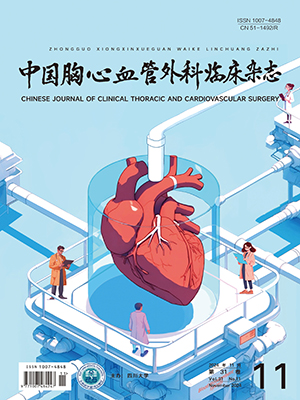Abstract: Objective To evaluate myocardial protection effect of different myocardial protective strategies for patients undergoing double valve replacement (DVR) . Methods From Jun. 2005 to Dec. 2005, 32 patients with predominant aortic valve stenosis undergoing DVR in Xinqiao Hospital were included in this study. These patients were randomly divided into four groups with 8 patients in each group: (1) antegrade perfusion group:Cold-blood cardioplegia was delivered antegradely through aortic root, and mitral valve replacement (MVR)was performed. Then cold-blood cardioplegia was delivered antegradely through left and right coronary ostia, and aortic valve replacement (AVR) was performed; (2)retrograde perfusion group:Cold-blood cardioplegia was delivered retrogradely and intermittently through coronary sinus, and DVR was performed; (3)antegrade+retrograde perfusion group:The route of cold-blood cardioplegic infusion was antegrade during MVR procedure first and then retrograde during AVR procedure;and (4)beating heart group:Oxygenated blood from cardiopulmonary bypass machine was delivered retrogradely and continuously through coronary sinus, and DVR was performed with beating heart. Early clinical outcomes were observed. Serum cardiac troponin I (cTnI) was measured by enzyme-linked immunosorbent assay(ELISA). Serum creatine kinase-MB (CK-MB) and myocardial lactic acid release rate were measured by Hitachi7150 Automatic Chemistry Analyzer. Myocardial mitochondria malondialdehyde (MDA) level was measured through thiobarbituric acid reagent species analysis. Results All the 32 patients survived their surgery and were discharged successfully. Myocardial lactic acid release rate at 80 min after aortic cross-clamping, serum cTnI and CK-MB on the first postoperative day, myocardial mitochondria MDA levels of beating heart group were 13.59%±6.27%,(1.17±0.25) ng/ml, (56.43±16.50) U/L and(2.18±1.23) nmol/(ng.prot)respectively, all significantly lower than those of retrograde perfusion group [(33.49%±8.29%, (1.82±0.58 )ng/ml, (78.31±21.27) U/L (5.07±2.35) nmol/(ng.prot),P<0.05] and antegrade+retrograde perfusion group[20.87%±7.22%, (1.49±0.23) ng/ml,(66.67±19.13) U/L,(4.34±1.73) nmol/(ng.prot),P<0.05], but not statistically different from those of antegrade perfusion group [18.83%±5.97%, (1.41±0.32) ng/ml, (63.21±37.52) U/L, (3.46±1.62) nmol/ (ng.prot),P>0.05]. Conclusion All the four myocardial protective strategies are effective myocardial protection methods for DVR patients. Continuous retrograde perfusion with beating heart and intermittent antegrade perfusion can provide better myocardial protection, and therefore are preferred for DVR patients. The combination of antegrade and retrograde perfusion is easy to administer and does not negatively influence surgical procedures. Retrograde perfusion is also effective as it takes only a short time.
Citation: CHEN Lin,XIAO Yingbin,XIAO Juan,CHEN Baicheng,WANG Xuefeng.. Myocardial Protection by Different Myocardial Protective Strategies in Double Valve Replacement. Chinese Journal of Clinical Thoracic and Cardiovascular Surgery, 2012, 19(4): 371-375. doi: Copy




